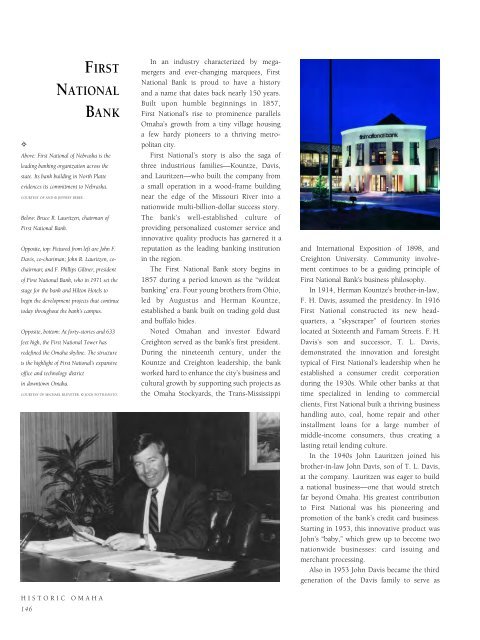Historic Omaha
An illustrated history of Omaha and the Douglas County area, paired with the histories of companies, families and organizations that make the region great.
An illustrated history of Omaha and the Douglas County area, paired with the histories of companies, families and organizations that make the region great.
Create successful ePaper yourself
Turn your PDF publications into a flip-book with our unique Google optimized e-Paper software.
FIRST<br />
NATIONAL<br />
BANK<br />
✧<br />
Above: First National of Nebraska is the<br />
leading banking organization across the<br />
state. Its bank building in North Platte<br />
evidences its commitment to Nebraska.<br />
COURTESY OF AND © JEFFREY BEBEE.<br />
Below: Bruce R. Lauritzen, chairman of<br />
First National Bank.<br />
Opposite, top: Pictured from left are John F.<br />
Davis, co-chariman; John R. Lauritzen, cochairman;<br />
and F. Phillips Giltner, president<br />
of First National Bank, who in 1971 set the<br />
stage for the bank and Hilton Hotels to<br />
begin the development projects that continue<br />
today throughout the bank’s campus.<br />
Opposite, bottom: At forty-stories and 633<br />
feet high, the First National Tower has<br />
redefined the <strong>Omaha</strong> skyline. The structure<br />
is the highlight of First National’s expansive<br />
office and technology district<br />
in downtown <strong>Omaha</strong>.<br />
COURTESY OF MICHAEL KLEVETER. © JOCK POTTLE/ESTO.<br />
HISTORIC OMAHA<br />
146<br />
In an industry characterized by megamergers<br />
and ever-changing marquees, First<br />
National Bank is proud to have a history<br />
and a name that dates back nearly 150 years.<br />
Built upon humble beginnings in 1857,<br />
First National’s rise to prominence parallels<br />
<strong>Omaha</strong>’s growth from a tiny village housing<br />
a few hardy pioneers to a thriving metropolitan<br />
city.<br />
First National’s story is also the saga of<br />
three industrious families—Kountze, Davis,<br />
and Lauritzen—who built the company from<br />
a small operation in a wood-frame building<br />
near the edge of the Missouri River into a<br />
nationwide multi-billion-dollar success story.<br />
The bank’s well-established culture of<br />
providing personalized customer service and<br />
innovative quality products has garnered it a<br />
reputation as the leading banking institution<br />
in the region.<br />
The First National Bank story begins in<br />
1857 during a period known as the “wildcat<br />
banking” era. Four young brothers from Ohio,<br />
led by Augustus and Herman Kountze,<br />
established a bank built on trading gold dust<br />
and buffalo hides.<br />
Noted <strong>Omaha</strong>n and investor Edward<br />
Creighton served as the bank’s first president.<br />
During the nineteenth century, under the<br />
Kountze and Creighton leadership, the bank<br />
worked hard to enhance the city’s business and<br />
cultural growth by supporting such projects as<br />
the <strong>Omaha</strong> Stockyards, the Trans-Mississippi<br />
and International Exposition of 1898, and<br />
Creighton University. Community involvement<br />
continues to be a guiding principle of<br />
First National Bank’s business philosophy.<br />
In 1914, Herman Kountze’s brother-in-law,<br />
F. H. Davis, assumed the presidency. In 1916<br />
First National constructed its new headquarters,<br />
a “skyscraper” of fourteen stories<br />
located at Sixteenth and Farnam Streets. F. H.<br />
Davis’s son and successor, T. L. Davis,<br />
demonstrated the innovation and foresight<br />
typical of First National’s leadership when he<br />
established a consumer credit corporation<br />
during the 1930s. While other banks at that<br />
time specialized in lending to commercial<br />
clients, First National built a thriving business<br />
handling auto, coal, home repair and other<br />
installment loans for a large number of<br />
middle-income consumers, thus creating a<br />
lasting retail lending culture.<br />
In the 1940s John Lauritzen joined his<br />
brother-in-law John Davis, son of T. L. Davis,<br />
at the company. Lauritzen was eager to build<br />
a national business—one that would stretch<br />
far beyond <strong>Omaha</strong>. His greatest contribution<br />
to First National was his pioneering and<br />
promotion of the bank’s credit card business.<br />
Starting in 1953, this innovative product was<br />
John’s “baby,” which grew up to become two<br />
nationwide businesses: card issuing and<br />
merchant processing.<br />
Also in 1953 John Davis became the third<br />
generation of the Davis family to serve as
















